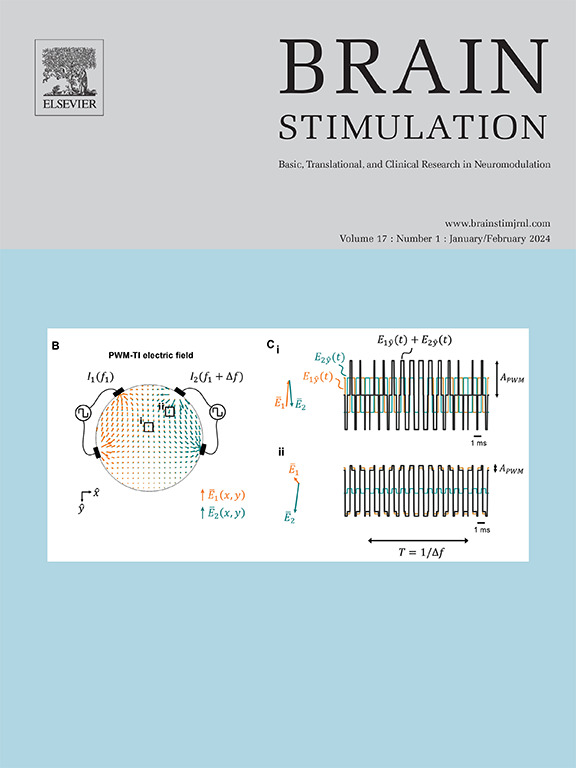Assessing tDCS efficacy in reducing negative symptoms in schizophrenia spectrum disorders: A systematic review and meta-analysis
IF 8.4
1区 医学
Q1 CLINICAL NEUROLOGY
引用次数: 0
Abstract
Background
Negative symptoms in schizophrenia spectrum disorders (SSDs) are associated with low functioning and reduced quality of life. Given the limited efficacy of current treatments, transcranial direct current stimulation (tDCS) has been studied as a potential add-on intervention, though findings to date have been mixed. Objective: This meta-analysis aims to assess the efficacy of tDCS for the reduction of negative symptoms in SSDs.
Methods
A systematic review and meta-analysis were conducted on randomized controlled trials comparing active to sham tDCS treatments applied to people diagnosed with SSDs (PROSPERO registration: CRD42024530612). Standardized mean differences (SMDs) were calculated, and subgroup and moderation analyses were performed to explore possible sources of heterogeneity.
Results
Across studies (k = 18; total n = 709; 361 participants in the active and 348 in the sham group), tDCS significantly reduced negative symptoms of SSDs, compared to sham stimulation, with moderate heterogeneity. Subgroup analysis showed greater efficacy when studies included only the diagnosis of schizophrenia (SMD = −0.51), and when negative symptoms were the primary outcome and the specific target of the intervention (SMD = −0.80). Stimulation over the left dorsolateral prefrontal cortex (lDLPFC) was significantly associated with symptom reduction (SMD = −0.30). No significant effects were found at follow-up, indicating limited persistence of treatment effects without maintenance sessions. tDCS was well tolerated and safe.
Discussion
tDCS shows significant modest effect for the reduction of negative symptoms of SSDs as an add-on treatment to medication, particularly when protocols target these symptoms and the anode is placed over the lDLPFC. Future studies should study the long-term effects of tDCS and how to boost long-term efficacy, as well as explore individual characteristics to tailor personalized interventions.
评估tDCS减轻精神分裂症谱系障碍阴性症状的疗效:一项系统回顾和荟萃分析
背景:精神分裂症谱系障碍(SSDs)的阴性症状与功能低下和生活质量下降有关。鉴于目前治疗方法的有效性有限,经颅直流电刺激(tDCS)作为一种潜在的附加干预手段进行了研究,尽管迄今为止的研究结果好坏参半。目的:本荟萃分析旨在评估tDCS减轻ssd患者阴性症状的疗效。方法:对随机对照试验进行系统评价和荟萃分析,比较active和sham tDCS治疗对诊断为ssd的患者的疗效(PROSPERO注册号:CRD42024530612)。计算标准化平均差异(SMDs),并进行亚组分析和适度分析以探索可能的异质性来源。结果:在所有研究中(k = 18;总n = 709;活动组361名参与者和假手术组348名参与者),与假手术刺激相比,tDCS显著减少了ssd的阴性症状,且具有中等异质性。亚组分析显示,当研究仅包括精神分裂症的诊断(SMD = -0.51),当阴性症状是主要结局和干预的特定目标(SMD = -0.80)时,效果更好。刺激左背外侧前额叶皮层(lDLPFC)与症状减轻显著相关(SMD = -0.30)。在随访中没有发现明显的效果,表明在没有维持期的情况下,治疗效果的持久性有限。tDCS耐受性良好且安全。讨论:tDCS作为药物治疗的附加治疗,在减少ssd的阴性症状方面显示出显著的适度效果,特别是当方案针对这些症状并将阳极置于lDLPFC上时。未来的研究应该研究tDCS的长期效果以及如何提高长期疗效,并探索个体特征以定制个性化干预措施。
本文章由计算机程序翻译,如有差异,请以英文原文为准。
求助全文
约1分钟内获得全文
求助全文
来源期刊

Brain Stimulation
医学-临床神经学
CiteScore
13.10
自引率
9.10%
发文量
256
审稿时长
72 days
期刊介绍:
Brain Stimulation publishes on the entire field of brain stimulation, including noninvasive and invasive techniques and technologies that alter brain function through the use of electrical, magnetic, radiowave, or focally targeted pharmacologic stimulation.
Brain Stimulation aims to be the premier journal for publication of original research in the field of neuromodulation. The journal includes: a) Original articles; b) Short Communications; c) Invited and original reviews; d) Technology and methodological perspectives (reviews of new devices, description of new methods, etc.); and e) Letters to the Editor. Special issues of the journal will be considered based on scientific merit.
 求助内容:
求助内容: 应助结果提醒方式:
应助结果提醒方式:


